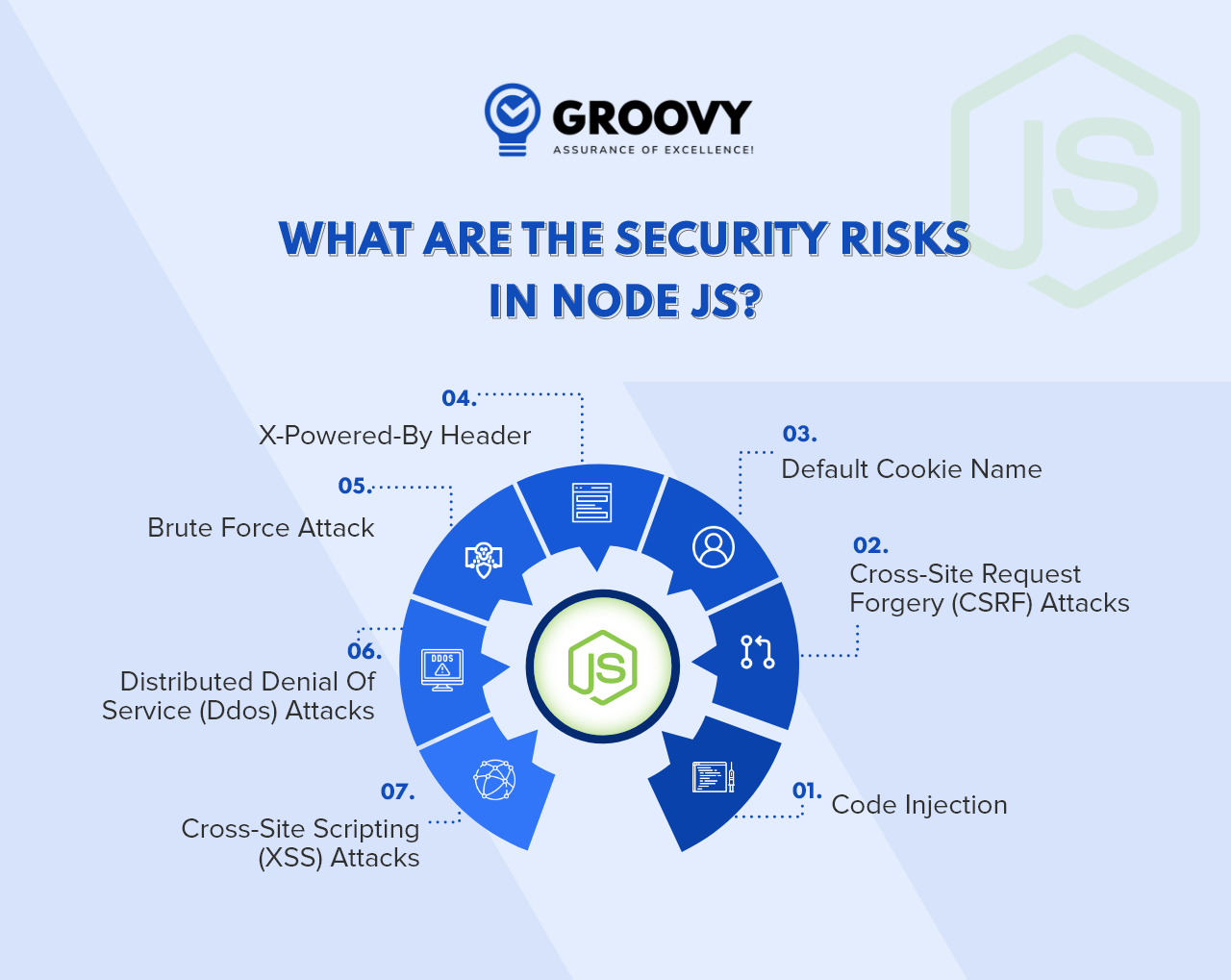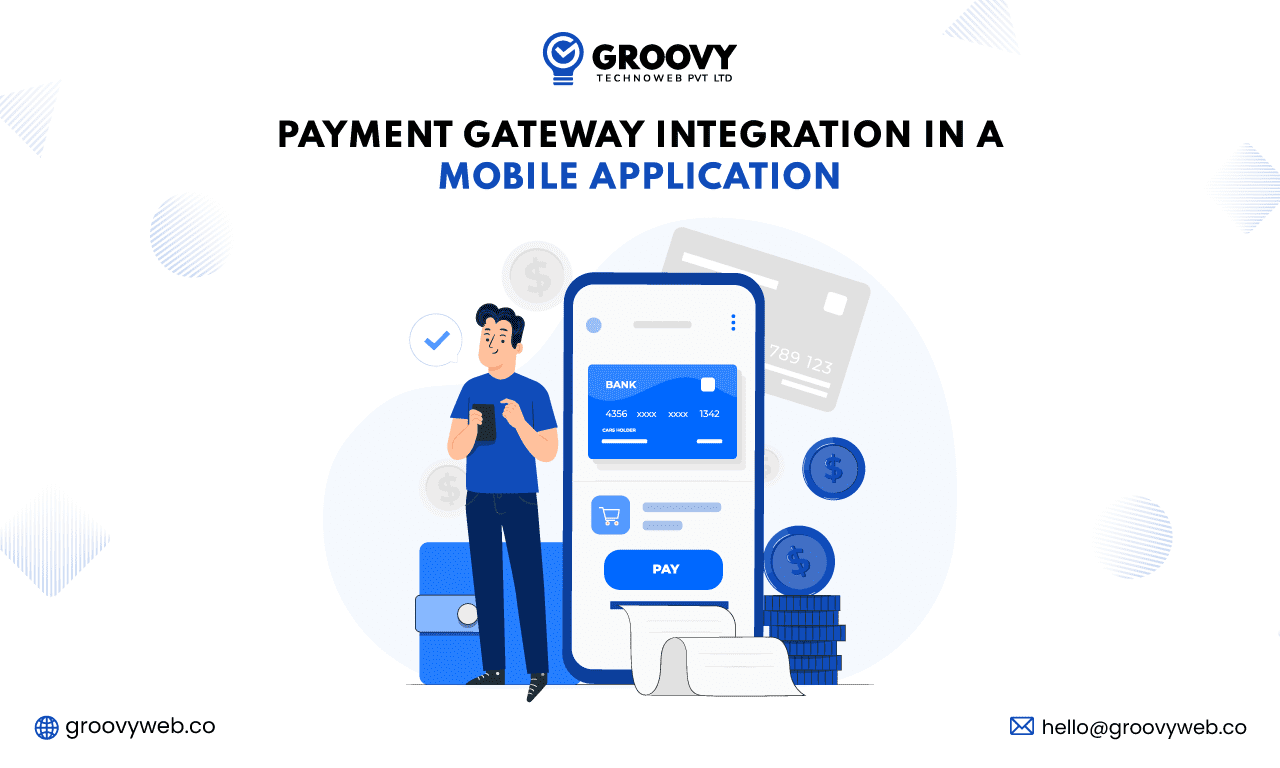Best Practices To Secure Node JS Application
Rahul Motwani
July 14, 2022 672 Views
Quick Summary : This article discusses the potential security risks of Node.js and the best practices to secure node js application.
Node.js is a technology that developers use to create web applications. It is intended to be entirely secure node js.
However, while developing any web application through Node JS, you will need to use a third-party open-source package. The security vulnerabilities are not new to open source backend frameworks, and every Node.js developer understands the risks of hackers for the user data as well as applications.
What Are Security Risks In Node JS?

The node.js security risks are given by,
Code Injection
Code injection means any attack where an attacker inserts code into a system and forces an application routine to perform. Attackers explore poorly managed and untrusted data to gain insights into your code base.
A common cause for this security risk is improper checks of input and output data. SQL injection is a recurring code injection attack that most people encounter during software development. Here, attackers use malicious SQL code to manipulate backend databases and gain access to sensitive data that isn’t generally visible.
Cross-Site Request Forgery (CSRF) Attacks
Cross-Site Request Forgery (CSRF) is a common node js security vulnerability that you should not ignore. CSRF attacks force authenticated users to send requests to web applications that they have been verified. It allows attackers to access sensitive information and comprises the privacy and integrity of web applications.
Cookies allow a website or web application to identify a specific user. This is because user actions on the web application are stored as cookies in the underlying infrastructure.
Shopping carts on ecommerce websites are the most common examples of cookies. Cookies, remember the items you select on the website, and when you move to the checkout page, the shopping cart will display those items.
Problems with Node.js development arise when developers choose to use the default cookie name instead of customization because the attacker knows the default cookie name. Based on this information, they are prone to attack and easily access user data within a complete ecosystem.
X-Powered-By Header
The X-Powered-By header is a common non-standard HTTP response header used by many scripting languages as a default option.
With the help of server and configuration management techniques, you can enable or disable this header. However, developers may fail to disable the X-Powered-By header and give attackers access to some sensitive information.
This header reveals the technology used to develop the app and allows attackers to exploit various security vulnerabilities.
Brute force attack
Brute-force attacks are one of the most recurring attacks or vulnerabilities you will find in the Node.js security checklist. Log in to the web application to access sensitive information.
Brutal forcing is making millions of combinations until you find the right password for your web application. To prevent brute attacks, you will need to strengthen the authentication mechanism for your Node.js application.
You can also limit the number of login attempts from a single IP to deal with such risky situations and use bcrypt.js to protect passwords stored in the database.
Distributed Denial of Service (DDoS) Attacks
A Distributed Denial of Service (DDoS) attack attempts to disrupt the normal traffic of a server, service, or network by overloading or loading a high-traffic production environment that might involve JavaScript code that is.
Node.js versions 4.0.0 and 4.1.1 cause DDoS attacks because they allow attackers to exploit bugs in HTTP handling. Limiting these kinds of attacks is critical to ensuring the smooth performance of your Node.js application, as it can damage servers, networks, or services and damage your complete ecosystem.
Cross-Site Scripting (XSS) attacks
Cross-site scripting attacks are critical threats that you must deal with while working on web application development. Node.js Cross-Site Scripting (XSS) allows attackers to inject relevant client-side scripts with the customized JavaScript code to the web app resulting from the hostname input validation returned by the missing Domain Name Servers.
An attacker can use XSS to deliver malicious scripts to end-users. And end-user browsers don’t have a way to determine the trust of the code base, so they do so by default, and an attacker can gain access to cookies, session tokens, or other sensitive information. These scripts can also rewrite the content of any HTML page, making XSS quite dangerous.
With enough knowledge of Node.js vulnerabilities, let’s decode best practices to help you prevent such situations.
Exploring The Best Practices For Security & Solutions Of Node Js
The list of node.js security best practices is given by,
Refrain From Leaking Information
Don’t just rely on what you get from the front end, but also what you are going to convey. You can easily pass all data for a specific object to the foreground and filter what is displayed there. However, it is quite easy for hackers to find hidden data sent from the backend.
Solution
Submit only the necessary information. In case you only need first and last names, just fetch the data from the database. This may require you to do a little more work. But it is absolutely worth it.
Use Safety Linters
You can automatically scan for vulnerabilities. Moreover, you can still detect basic security risks even while coding.
Solution
You can use a linter plug-in like eslint-plugin-security. This type of security information alerts you every time you use insecure code practices.
Apply Access Control On Each Request
This usually involves checking the app properly. When it comes to user permissions to different URLs or areas of the app, in case you want to have limited space in the app like admin dashboard, for example, and normal users without proper roles will be able to access it.
Solution
The best way to eliminate this sensitivity is to test app modules that require specific user permissions manually. Middleware and access control rules are best implemented on the server-side.
This reduces the opportunity for client-side access management with JWT (JSON Web Token) authorization tokens or cookies. Log access controls and API rate limits must be set up. This is how administrators are notified when critical steps should be taken to mitigate repeated attacks and failures.
Create Recordings And Audits
Logging and auditing are also tied to secure node js. Ultimately, your goal is to build a security mechanism from scratch, but it actually requires ongoing steps, and for this, you must have it recorded and reviewed.
Solution
Some hackers want to make your app inoperable, which can be found without recording, but some hackers want to remain anonymous for a long time. For this case Reviewing logs and metrics can help you spot inaccuracies.
With just the basic recording, you can’t get enough information for understanding. If you get strange requests from your own apps, hackers, or third-party APIs, There are many tools and tools to talk and mix with. We offer a precise layer for improving the protection of your system.
It is critical to assess and identify potential risks and compromises of your app. You can create multiple routines that apply depending on a few predefined system behaviours. Logging and monitoring explain everything that happens within the app. Therefore, monitoring acts as a sound that will come to you if a vulnerability is detected.
Perform Strong And Complete Authentication
An authentication system that is incomplete, weak, or inoperable is another common vulnerability. This may happen because many developers think they are secure, but in reality, Unstable or weak authentication is easy to hack.
Solution
One important fix is to use a current authentication solution in case you want to use a Node.js authentication solution. While creating a password, don’t use built-in Node.js cryptographic libraries; instead, use Scrypt or Bcrypt. Be sure to limit failed login attempts. And don’t tell the user if the password or username is incorrect.
Additionally, you must have an appropriate session management policy. Make sure to perform 2FA authentication. If done properly, it can increase app security a lot. You can do this using modules like Speakeasy or node-2fa.
Automatically Scans Apps For Vulnerabilities
The Node.js ecosystem consists of libraries and modules. This poses a security risk. You cannot be entirely sure it is safe while using code written by someone else.
Solution
To solve this problem, you need to run automatic vulnerability scans regularly. This allows you to find dependencies that have common vulnerabilities. Additionally, you can select NPM analysis for essential monitoring.
Build a Fluid Pipeline for Security Patches
A web server or app is unprotected or protected by weak security standards. Misconfigured security vulnerabilities also occur. Because of this vulnerability, many parts of the app stack (App containers, databases, servers, etc.) are therefore more prone to attack by vulnerabilities.
Weak build pipelines are a critical starting point for Misconfigured security-type attacks, such as provisioning or development space credentials that sometimes cause builds. This allows the app to be exposed as a staging configuration or development area to meet loose security standards.
Solution
It is recommended that you keep all environments equal to different credentials and access levels. The default package settings and user account passwords also introduce vulnerabilities in Node.js apps, as hackers can launch aggressive dictionary attacks against login forms with weak credentials. On the other hand, default package settings leave a hole for malicious hackers.
Why Is The Node.js Project Experience A Security Risk?
Open-source applications do not inherit security and licensing issues from open-source components. The problem is that security testing tools such as dynamic and static code analysis are ineffective at detecting open source vulnerabilities.
To identify open source components in Node.js, you must parse the package manager index file that describes dependencies. However, the index file does not include recycled open source components.
The community of open-source often reuses open-source projects to accelerate development. Reduce time to market and integrate functionality.
Thereby, both open-source and commercial developers can introduce functions, code snippets, and methods into files. The result is that many Node.js projects have license terms in addition to the original Node.js license.
The security of code-related activities is one of the key factors that modern decision-makers need to consider.
Node.js is a very secure platform in its current state. As with any framework in the world, you always have to question whether the practices you use make sense from a long-term security standpoint.
NPM stands for Node.js Package Manager. This database offers the user access to add-ons. The problem with the platform lies in the inability to re-examine all available packages.
As a result, the likelihood of getting exploit-focused errors is high through the platform to eliminate the hazards in question. The most sensible solution is to invest a significant amount of time in code review, so NPM, although convenient, takes a lot of effort to detect potential hazards.
There are many ways to create mobile apps in the market. And we are experts at some of the best technologies to develop custom mobile applications.
Groovy Web uses the latest high-end technology to create attractive, easy-to-use, and widely accepted iOS and Android mobile applications.
Our specialists go through the process of creating an application. From design to clickable prototypes, this helps to understand market needs and potential users. Our development team creates a robust, secure, scalable, and connected web platform.
Conclusion
Over the years, Security risks and threats lead to cost companies thousands of dollars. Although the leak caused a large hole in the pocket but leaked sensitive data and compromised data cannot be priced simply in volume. We may not be able to stop every attack that an attacker may initiate to harm our app. But we can be sure that our carelessness will not cause much damage.
In this article, the intent is not only to describe best practices that should be followed while developing an application.
But also, safety must be taken into account at every stage of the software development lifecycle. If you are experiencing any issues, consult our expert, we are here to help you through consulting and development.
You can also hire a Node.js development company for successful Node.js application development. Adopting modern Node.js security practices will allow app developers to build a more secure system for their users
Written by: Rahul Motwani
Rahul Motwani is an experienced Project Manager with a demonstrated history of working in the information technology and services industry. He started his career as a Backend developer and currently has his hands-on managing projects at Groovy Web. He is a strong program and project management professional with a Bachelor's degree focused on Computer Application.
Frequently Asked Questions
We hope these clear your doubts, but if you still have any questions, then feel free to write us on hello@groovyweb.coHow can I prevent cross-site scripting (XSS) attacks in my Node.js application?
It's hard to validate and sanitise user input to prevent cross-site scripting (XSS) attacks. To verify that user input is acceptable to show on a web page, use a package like DOMPurify or built-in methods like encodeURIComponent() or encodeURI(). You may also employ a Content Security Policy (CSP) to assist prevent XSS attacks.
How can I prevent cross-site request forgery (CSRF) attacks in my Node.js application?
You may use a CSRF token to confirm that requests sent to your application are valid in order to avoid cross-site request forgery (CSRF) attacks. The token can be placed as a hidden field in a form or as a cookie, and it must be validated on the server before any sensitive operations are performed. You may also use a library like csurf to assist you build CSRF protection in your application.
Related Blog

Krunal Panchal
How to Integrate Payment Gateway in Mobile Application
Mobile App Development 25 May 2023 11 min read
Sagar Patel
What are The Differences Between Web Apps and Mobile Apps?
Web App Development 06 Feb 2023 21 min readSign up for the free Newsletter
For exclusive strategies not found on the blog
